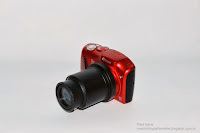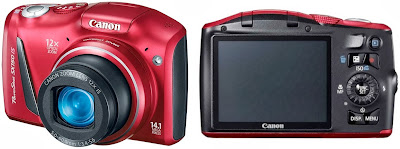MACROFOTOGRAFIA ONLINE
MACRO COM CÂMERAS COMPACTAS
MACRO WITH POINT-AND-SHOOT CAMERAS
Neste artigo apresento os métodos e soluções que usei/uso para fazer Macrofotografia com câmeras compactas.
Sugiro que leia também os artigos Conceitos Macro e Recursos em Câmeras.
CÂMERAS COMPACTAS
Minha primeira câmera digital compacta foi uma Sony Cybershot DSC-W1 de 5M pixels e 3x zoom óptico, e foi com ela que iniciei na Macrofotografia a partir de 2005:
|
This article presents the methods and solutions I've used to make Macrophotography with point-and-shoot cameras.
I suggest you also read the articles Macro Concepts and Built-In Resources for Macro.
COMPACT CAMERAS
My first compact digital camera was a Sony Cybershot DSC-W1 5M pixels with 3x optical zoom. I began in macrophotography in 2005 with this camera:
|
|
| |
Anos depois comprei uma Fujifilm Finepix S8100FD com 10 megapixels e 18x zoom óptico:
|
Years later I bought a Fujifilm Finepix S8100fd with 10 megapixels and 18x optical zoom:
|
|
| |
Minha última compacta foi esta Canon Powershot SX150IS com 14.1 megapixels e 12x zoom óptico:
|
This was my last compact camera, a Canon Powershot SX150IS with 14.1 megapixels and 12x optical zoom:
|
|
| |
Embora todas as câmeras compactas tenham um recurso macro nativo (aquele símbolo de uma flor), na realidade, a ampliação não é suficiente para chamarmos de Macrofotografia, mas sim, Close-up.
No caso da câmera Fujifilm ela veio com dois recursos: Macro e SuperMacro. Mesmo assim, trata-se de close-up.
Na seção artigos coloquei um post sobre os recursos nativos de câmeras que você deve considerar, antes de comprar a sua, ou, caso já tenha uma compacta, saiba como utilizar estes recursos para Macrofotografia.
LENTES:
Para chegarmos na Macrofotografia, ou seja, enquadrarmos um assunto com ampliação 1:1 no sensor, precisamos acoplar lentes externas na objetiva da câmera.
No meu caso, utilizei/utilizo objetivas de um binóculo antigo de meu avô 4x30mm (4x aumento x 30mm diâmetro) (foto abaixo):
|
Although all compact cameras have a native macro feature (that little flower symbol), in fact, the magnification is not enough to call it macrophotography, but actually, Close-up.
In the case of Fujifilm camera it came with two features: macro and super macro. Still, it's all Close-up.
In the articles section I wrote a post about built-in camera features that you should consider before buying yours, or if you already have a compact, it will help you to know how to use these resources for macrophotography.
LENS:
To get into macrophotography, ie to frame an issue with magnification 1:1 at the sensor, we need to attach external lenses to the camera lens.
In my case, I used / use an old binocular of my grandfather, 4x30mm (4x zoom x 30mm diameter) (photo below):
|
Gostei tanto deste binóculo que achei outro igual no Mercado Livre e comprei mais um para acoplar 4 objetivas consecutivas.
Para realizar mais alguns testes cheguei a comprar um binóculo baratinho também, com lentes de acrílico, mas os resultados foram péssimos.
Lupas também não funcionaram bem!.
Não adianta, procure um binóculo de boa qualidade, com lentes de vidro, principalmente um modelo que permita a retirada das lentes.
Fiz algumas tentativas com lentes de um binóculo grande 16x50mm também, mas não ficaram boas.
As dimensões 4x30mm serviram muito bem para mim em três modelos de câmeras compactas, inclusive para uma Reflex (DSLR) (veja artigo específico sobre Macrofotografia com este tipo de câmera).
Agora, isto depende também do diâmetro da objetiva de sua câmera. Se for igual ou maior que o diâmetro da lente, haverá distorções ou vignetting.
Outra solução que funcionou bem pra mim com a Câmera Sony foi a utilização de uma ocular de telescópio 20 mm (este valor é a distância focal da lente e está escrito na ocular). Microscópios também possuem ótimas oculares.
Funcionou com a Sony pois o diâmetro da objetiva da câmera era próximo ao diâmetro da ocular.
Se a sua câmera possui objetiva com diâmetro pequeno, sugiro comprar oculares de até 20 mm (1cm diâmetro). Menos que isto, embora consiga ampliações gigantescas, o diâmetro da lente será tão pequeno que o acoplamento óptico com a objetiva da câmera irá distorcer a imagem, além de surgir vignetting extremo e aberração cromática (leia o artigo Conceitos Macro).
Veja abaixo a solução que eu uso com lente de telescópio:
|
I liked this binocular so much that I found another one on the Net and bought it to connect four consecutive lenses.
To carry out some more tests I came to buy a cheapie binocular too, with acrylic lenses, but the results were terrible.
Magnifying lenses also did not work well!.
Look out for a good quality binocular with glass lenses, especially a model that allows removal of the lenses.
I made some attempts with large binoculars 16x50mm too, but it didn’t work well also.
The dimensions 4x30mm served very well for me in three models of compact cameras plus a DSLR (see specific article I wrote about macrophotography with this type of camera).
It also depends on the diameter of the lens of your camera. If your camera has equal or greater diameter than the binocular lens, you may have distortion or vignetting.
Another solution that worked well for me with the Sony camera was using a 20 mm telescope eyepiece (“20 mm” is the lens focal length and it’s written in the eyepiece). Microscopes also have great eyepieces.
It worked with Sony because the diameter of the camera lens was close to the diameter of the eyepiece.
If your camera has a lens with small diameter, I suggest you to buy eyepieces up to 20 mm (1 cm diameter). Less than that you will achieve gigantic magnifications but the lens diameter will be so small that the optical coupling with the camera lens will distort the image, and emerge extreme vignetting and chromatic aberration (read the article Macro Concepts).
You can see below this solution I use with telescope eyepiece:
|
ACOPLAMENTO DAS LENTES NA CÂMERA
Acoplar as lentes diretamente em uma câmera nunca é uma tarefa fácil.
Normalmente as câmeras compactas não possuem rosca para acoplamento de filtros e lentes, como as Reflex (DSLR).
Tentar segurar a câmera, segurar a lente e movimentar o conjunto em busca de foco para fotografar um assunto em movimento é impossível, esqueça!.
Para cada modelo de câmera compacta que utilizo/utilizei sempre recorri a um eterno amigo: tubos e conexões de PVC!.
Não importa o corpo da câmera, você sempre, sempre, vai achar alguma solução com tubos e conexões PVC que, com maior ou menor adaptação, vai encaixar no seu modelo.
Quando fizer suas montagens, sugiro pintar interna (preto) e externamente. PVCs brancos ao receberem luz direta podem ofuscar e gerar reflexões internas que ofuscam as imagens.
Veja abaixo as adaptações que construí para cada modelo de câmera.
Note que, para as câmeras Canon Powershot e Fujifilm, as lentes estão invertidas para melhor acoplamento óptico pois possuem muito zoom:
|
COUPLING THE LENSES TO THE CAMERA
To attach the lens directly into a camera is never an easy task.
Typically compact cameras do not have thread for coupling filters and lenses, such as DSLR cameras.
To try to hold the camera, hold the lens and move the set in search of focus to shoot a moving subject is impossible, forget it!.
For each type of compact camera that I use I always resorted to an eternal friend: PVC pipes and fittings!.
No matter the camera body, you will always, always, find some solution with PVC pipes and fittings, with more or less adaptations to fit in your model.
When making your mounts I suggest you paint the internal (black) and external sides. When hit by direct light white PVC may obfuscate and generate internal reflections if it’s not painted.
You can see below some setups I designed to each camera model.
Note that for the cameras Canon Powershot and Fujifilm the binocular lenses are inverted for better optical coupling, due to the high zoom of the cameras:
|
Camera Sony Cybershot DSC-W1:
| |
|
| |
Camera Sony Cybershot DSC-W1 com ocular de telescópio 20mm
(20mm telescope eyepiece): | |
|
| |
Camera Fujifilm Finepix S8100FD:
| |
|
| |
Camera Canon Powershot SX150IS:
| |
|
COMPARATIVO ENTRE AS CÂMERAS
Uma das coisas mais interessantes para mim é buscar combinar lentes e câmeras das mais variadas maneiras para atingir cada vez maiores ampliações.
Entretanto, acabei descobrindo a duras penas que, nem sempre maiores ampliações significam boas fotos.
Por exemplo, quando comprei a Câmera FujiFilm fiquei muito animado com o zoom óptico de 18x. Imaginei que, ao acionar o modo macro, acoplar as lentes e acionar o zoom, conseguiria atingir ampliações extremas, muito além dos 3x zoom óptico que conseguia com a Sony.
Realmente atingi tais ampliações, mas o acoplamento óptico de muitas lentes (internas da câmera e as do binóculo) conjugadas, o diâmetro da objetiva da câmera igual ao diâmetro das lentes de binóculo e a abertura que não passava de f 8, esbranquiçaram tanto as imagens e deixaram com profundidade de campo tão rasa que ficou impossível utilizar todo o zoom óptico da câmera.
As imagens ficavam boas até 10x zoom óptico. O mesmo ocorreu com a Canon Powershot.
Veja abaixo o comparativo de ampliações que fiz para cada câmera, incluindo uma Reflex (DSLR) para ilustração:
|
COMPARISON BETWEEN THE CAMERAS
One of the most interesting things to me is to seek combinations between lenses and cameras to achieve increasingly higher magnifications.
However, I discovered on a hard way that higher magnifications does not mean good pictures.
For example, when I bought the FujiFilm camera I was very excited with the 18x optical zoom. I figured that when I trigger the macro mode, attach the lens and push the zoom to maximum I would reach extreme magnifications, far beyond the 3x optical zoom that I was used to get with Sony camera.
I actually achieved such expansion, but due to many optical coupling lenses (internal camera’s and the binocular’s) conjugated, due to the diameter of the camera’s objective equal to the binocular lens diameter and the low aperture f (8) provided by the camera, the images were whitish and had shallow depth of field. So it was impossible to use the full optical zoom of the camera.
The pictures were good up to 10x optical zoom. It was the same with the Canon Powershot camera.
Below you can see a comparison of magnifications that I made for each camera, including a DSLR for illustration:
|
Camera Sony Cybershot DSC-W1:
| |
|
| |
Camera Sony Cybershot DSC-W1 com ocular de telescópio 20mm
(20mm telescope eyepiece): | |
|
| |
Camera Fujifilm Finepix S8100FD:
| |
|
| |
Camera Canon Powershot SX150IS:
| |
Canon EOS REBEL T3i 600D (Reflex DSLR):
| |

































0 comentários:
Postar um comentário